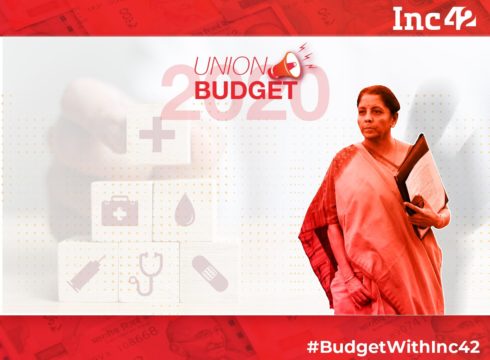SUMMARY
The government has a holistic vision of healthcare that translates into the wellness of the citizen
The minister proposed to set up a viability gap funding window for setting up hospitals
The finance minister proposed to impose a nominal health cess
Inc42 Daily Brief
Stay Ahead With Daily News & Analysis on India’s Tech & Startup Economy
“Aspirational India in which all sections of the society seek better standards of living, with access to health, education and better jobs,” finance minister Nirmala Sitharaman said while presenting the Union Budget 2020-21.
Sitharaman today presented the union budget 2020, which pitched for an outlay of INR 69,000 Cr ($9.6 Bn) towards healthcare, a nearly 10% increase from last year.
The minister said that the government has a holistic vision of healthcare that translates into the wellness of the citizen. The allotment under healthcare includes INR 6400 Cr for Prime Minister Jan Arogya Yojana (PMJAY).
Looking to expand the reach of PMJAY in Tier 2 and Tier 3 markets, Sitharaman said PMJAY currently has more than 20K empanelled hospitals.
The minister also proposed to expand Jan Aushadhi Kendra Scheme to all districts offering 2000 medicines and 300 surgical instruments by 2024.
Rashie Jain, CEO and cofounder of Onco, a healthtech startup said, “The allocation of INR 69,000 Cr in the budget towards better healthcare for Tier 2 and 3 towns, is a welcome move. Extending Jan Arogya Yojana to bring more underprivileged within the insurance ambit and will go a long way towards ensuring better healthcare and treatment options.”
Further, the finance minister proposed to impose a nominal health cess, by way of a duty of customs, on the imports of medical equipment, with the view that these goods are now being made significantly in India. “The proceeds from this cess shall be used for creating an infrastructure for health services in the aspirational districts,” the minister explained.
The minister proposed to set up a viability gap funding window for setting up hospitals in the public-private partnership (PPP) model. In the first phase, out of the 112 aspirational districts, the districts with no Ayushman empanelled hospitals will be preferred. “This would also provide large scale employment opportunities to youth,” the minister added.
“Using machine learning and AI, in the Ayushman Bharat scheme, health authorities and the medical fraternity can target disease with an appropriately designed preventive regime,” Sitharaman said.
Akansh Khurana, cofounder and CEO, THB: Technology Healthcare Big Data Analytics, said, “Use of new-age technology such as IoT devices, smartphones, smartwatches etc. to diagnose and monitor real-time health and seeing tangible outcomes through a focus on fitness and diet can empower #FitIndia campaign.”
Ashish Mehrotra, MD and CEO, Max Bupa Health Insurance said, “The clear focus of the budget is to make healthcare more accessible with increased infrastructure, as the investment on the healthcare sector has gone up from the previous year.
However, Mehrotra said that the budget didn’t address the long-pending request of the health insurance industry to remove or minimize GST slab for health insurance premiums paid. ”As health insurance penetration is still low in the country, change in the GST slab could have been a big driving factor for the consumers to invest in health insurance,” he added.
The finance minister also talked about the Fit India movement saying that it is a vital part of the fight against non-communicable diseases coming out of lifestyle issues.
“The budget has rightly emphasised on addressing the issue of growing non-communicable diseases which are essentially lifestyle diseases. In addition, as a part of the holistic vision of healthcare, the capital push through PM Jan Arogya Yojana will create awareness on health and wellness across India which will have a positive rub-off on healthcare products and service providers,” said Ameve Sharma, Founder, Kapiva.
India’s healthcare market is set to hit $372 Bn by 2022 and it is expected to create 40 Mn jobs by 2030. Currently, there are around 3K startups many of which have successfully brought healthcare services to patients’ homes.
However, healthtech is here to complement healthcare and not to replace it. And, the government needs to look at how both could co-create services that could help solve India’s looming healthcare issues.
Click Here To Read Inc42’s Live Coverage Of Union Budget 2020
Note: We at Inc42 take our ethics very seriously. More information about it can be found here.


